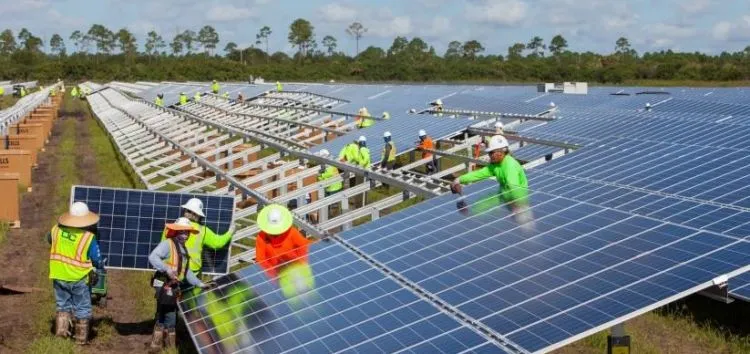NextEra upbeat on solar grid parity, standalone storage prospects
- New-build solar and wind could outcompete most existing fossil fuels by 2025, NextEra Energy executives have predicted even as they described storage-only ventures as a worthy venture.

Jim Robo, chair and CEO of the energy giant, shared the firm’s bullish outlook on renewable project economics as he spoke on a recent conference call discussing its full-year financial results.
Predicting lower prices for new near-firm wind (US$20-30/MWh) and solar (US$30-40/MWh) by 2025, Robo added: “At these prices, new near-firm renewables will be cheaper than the operating costs of most existing coal, nuclear and less fuel efficient oil and gas-fired generation units.”
The remarks came as results for NextEra Energy Resources, its flagship development arm, showed the unit commissioned 2.7GW across all renewables last year. Between January and December, the firm claims to have amassed a PV, wind and battery project backlog of 5.8GW.
According to NextEra, 1.6GW of the full-year 5.8GW backlog boost was added between October and December alone. This last-minute surge included 770MW of new solar and 340MW of new battery storage, the firm said, noting that the latter will be fully collocated alongside solar.
NextEra used the financial update to offer a timetable for solar plays through 2022 and beyond. The firm claims to have signed 1.4GW worth of 2019-2020 solar contracts (out of the 1-2.5GW it was expecting), coupled with 2.9GW for 2021-2022, compared to 2.8GW-4.8GW expectations.
GAAP net income drops as Nasdaq shares rally
NextEra’s backlog bump came as its Energy Resources unit posted GAAP-based net income of US$1.8 billion for 2019, down from US$4.7 billion in 2018. The decline extended to the entire NextEra group, with GAAP net income dropping from 2018 (US$6.6 billion) to 2019 (US$3.7 billion).
The firm claimed using a non-GAAP metric – what it described as adjustable earnings – revealed instead a 2018-to-2019 jump for the NextEra group, from US$3.67 billion to US$4 billion. NextEra said it believes the metric offers a “more meaningful representation” of its earnings power.
The wider market appeared to endorse NextEra’s claims of a financially sound 2019. When trading ended last Friday, the firm’s shares on New York exchange Nasdaq had rallied to a 52-week peak of US$264.08, according to a statement by the trading venue.
The firm’s update extended to its Florida Power & Light (FPL) subsidiary, which is working on a “30 by 30” plan to install 30 million solar panels (a 10GW pipeline all in all) across the US state by 2030. Over 2019, the firm completed the 74.5MW Okeechobee solar complex.
Further Florida developments are “progressing well”, said NextEra CFO Rebecca Kujawa. Construction of a 750MW pipeline across ten projects is “on track and on budget” to start supplying FPL customers in early 2020, added Kujawa, who is also an executive VP.
Another of the group’s Florida-based subsidiaries – utility Gulf Power, which may merge with FPL in the future – is too working to deliver its own solar debut. The so-called Indigo Solar Energy Center, boasting some 75MW in capacity, should go online later in Q1 2020.
Storage, a business 'in its own right'
NextEra’s update gave ample evidence of the central role energy storage is set to play in the firm’s portfolio going forward.
As CEO Jim Robo noted, over 50% of all solar capacity added to the project pipeline in 2019 features a battery element. “The current backlog has more than 2,000 megawatts of trifecta projects that combine wind, solar and battery storage together,” the executive added.
NextEra’s separate timetables for energy storage show its portfolio will sharply rise between 2019-2020 (22MW signed where 50-150MW is expected) and 2021-2022 (591MW signed, 650-1,250MW forecasts). Post-2020, the firm claims to have signed deals for 786MW of storage.
The firm, Robo anticipated, may follow by embracing storage even more decisively. “We also increasingly see storage as an important stand-alone business in its own right as we are reviewing a number of opportunities to add storage to our existing solar sites,” the executive said.
Also read

